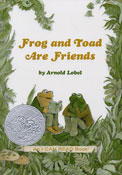What We're Reading Now
25 March 2011
Prompted by a visit from her niece, Rachel revisited the stories from Frog and Toad Are Friends by Arnold Lobel. She's glad she did -- bedtime stories have lessons for grown-ups, too.
Tags: picture books
At Allison Partners, we're always on the lookout for some good metaphors. They're great tools for illustrating concepts, and they often provide a gateway for organizations to have productive conversations about otherwise undiscussable subjects. (Patrick Lencioni, one of whose books Allison wrote about a while back, is a master in this arena.) That said, sometimes the metaphors can catch us by surprise, and that was the case for me this past week.

As part of the bedtime ritual for my visiting niece, Lucy, I was brought back to my own childhood days with Amelia Bedelia and Frog and Toad. I was expecting some reminiscing and, let's be honest, an experience that would be far more amusing to a four-year-old than a (mostly) grown-up. What I found instead were tales that were at times heartwarming (as when Frog sends Toad some authentic snail mail to fill his mailbox) and silly (really, what isn't silly about the notion of a frog and a toad who wear clothes and happen to be the best of friends). And a great big metaphor that was a big boost to my week.
In one adventure, Frog is feeling a bit under the weather so Toad sends him to bed and offers to tell him a story to help him rest. Unfortunately, Toad has difficulty thinking of a story and tries some unusual (and ineffective) methods for coming up with a good idea. By the time he finishes banging his head against a wall, Toad feels a bit ill himself and trades places with Frog. Frog then proceeds to tell Toad a story (and a hilarious one at that, judging by Lucy's giggles) about a toad who did some pretty silly things while trying to tell his friend a story.
My mind was probably already primed to see the metaphor since I was getting ready to teach yesterday's class about creativity and idea generation. Regardless, Frog and Toad's adventures were a pretty powerful illustration of the remarkable power of observation. How often do we not see what's right in front of our noses, or make a problem more difficult than it needs to be? There are some tips here for all of us: slow down, take notice of what's happening, and use the stimuli all around you to create something new. Thanks for the lesson, Lucy!








Comments
Our Comment Policy:
Our blog posts are only half of the conversation. What our readers have to say is equally important to us, and we're grateful for all the comments that continue the dialog.
To ensure that the discussion here is as useful as possible to all of our readers, please be respectful of our contributors and refrain from harassing, threatening and/or vulgar language. We reserve the right to screen and remove any comments from the site. If you have a question about a comment or want to discuss our policy, please contact us. We'll talk it over.
There are no comments for this entry yet.